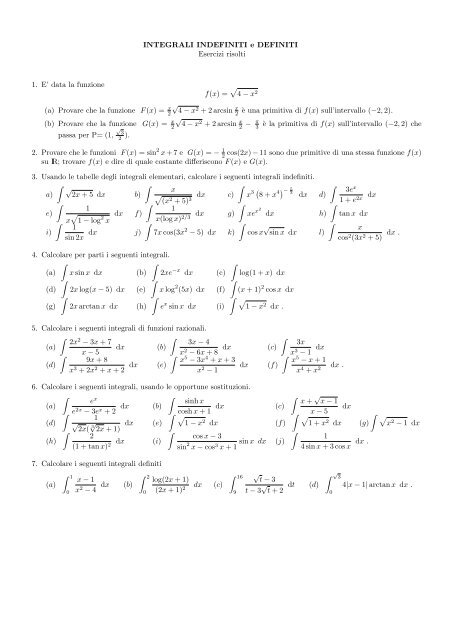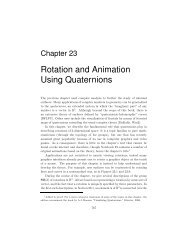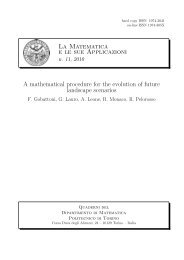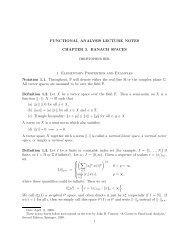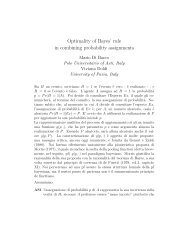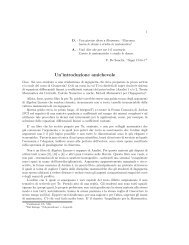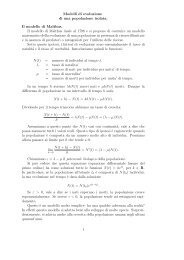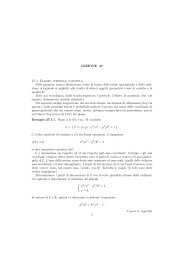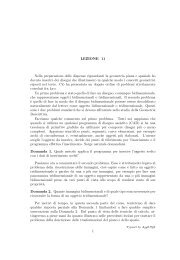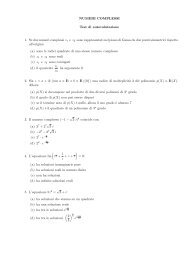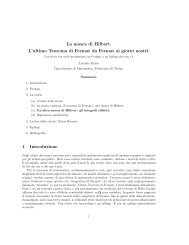INTEGRALI INDEFINITI e DEFINITI Esercizi risolti 1. E' data la ...
INTEGRALI INDEFINITI e DEFINITI Esercizi risolti 1. E' data la ...
INTEGRALI INDEFINITI e DEFINITI Esercizi risolti 1. E' data la ...
Create successful ePaper yourself
Turn your PDF publications into a flip-book with our unique Google optimized e-Paper software.
<strong>1.</strong> E’ <strong>data</strong> <strong>la</strong> funzione<br />
<strong>INTEGRALI</strong> <strong>IN<strong>DEFINITI</strong></strong> e <strong>DEFINITI</strong><br />
<strong>Esercizi</strong> <strong>risolti</strong><br />
f(x) = 4 − x 2<br />
(a) Provare che <strong>la</strong> funzione F (x) = x<br />
√<br />
2 4 − x2 x + 2 arcsin 2<br />
(b) Provare che <strong>la</strong> funzione G(x) = x<br />
2<br />
passa per P= (1, √ 3<br />
2 ).<br />
√<br />
4 − x2 x π<br />
+ 2 arcsin 2 − 3<br />
2. Provare che le funzioni F (x) = sin 2 x + 7 e G(x) = − 1<br />
2<br />
è una primitiva di f(x) sull’intervallo (−2, 2).<br />
è <strong>la</strong> primitiva di f(x) sull’intervallo (−2, 2) che<br />
cos(2x) − 11 sono due primitive di una stessa funzione f(x)<br />
su IR; trovare f(x) e dire di quale costante differiscono F (x) e G(x).<br />
3. Usando le tabelle degli integrali elementari, calco<strong>la</strong>re i seguenti integrali indefiniti.<br />
<br />
√2x<br />
a) + 5 dx<br />
<br />
x<br />
b) dx<br />
(x2 + 5) 3<br />
<br />
c) x 3 8 + x 4− 5<br />
<br />
1<br />
e)<br />
x<br />
3 dx<br />
<br />
d)<br />
1 − log 2 dx<br />
x<br />
<br />
1<br />
f)<br />
dx<br />
x(log x) 2/3<br />
<br />
g) xe x2<br />
<br />
1<br />
i) dx<br />
sin 2x<br />
<br />
j) 7x cos(3x<br />
dx<br />
<br />
h) tan x dx<br />
2 − 5) dx<br />
<br />
k) cos x √ sin x dx<br />
<br />
l)<br />
4. Calco<strong>la</strong>re per parti i seguenti integrali.<br />
<br />
<br />
(a) x sin x dx (b) 2xe −x <br />
<br />
<br />
dx (c) log(1 + x) dx<br />
(d) 2x log(x − 5) dx (e) x log 2 <br />
(5x) dx (f) (x + 1) 2 (g)<br />
<br />
2x arctan x dx (h)<br />
<br />
e<br />
cos x dx<br />
x sin x dx (i)<br />
1<br />
− x2 dx .<br />
5. Calco<strong>la</strong>re i seguenti integrali di funzioni razionali.<br />
2 2x − 3x + 7<br />
(a)<br />
dx<br />
x − 5<br />
<br />
3x − 4<br />
(b)<br />
x2 dx<br />
− 6x + 8<br />
<br />
3x<br />
(c)<br />
x3 − 1 dx<br />
<br />
9x + 8<br />
(d)<br />
x3 + 2x2 dx<br />
+ x + 2<br />
5 4 x − 3x + x + 3<br />
(e)<br />
x2 − 1<br />
dx<br />
5 x − x + 1<br />
(f)<br />
x4 + x2 dx .<br />
6. Calco<strong>la</strong>re i seguenti integrali, usando le opportune sostituzioni.<br />
(a)<br />
<br />
ex e2x − 3ex (d)<br />
<br />
dx<br />
+ 2<br />
1<br />
√ 3<br />
2x(<br />
(b)<br />
<br />
sinh x<br />
dx<br />
cosh x + 1<br />
(c)<br />
√ (h)<br />
<br />
dx<br />
2x + 1)<br />
2<br />
dx<br />
(1 + tan x) 2<br />
(e)<br />
(i)<br />
1<br />
− x2 dx<br />
<br />
(f)<br />
7. Calco<strong>la</strong>re i seguenti integrali definiti<br />
(a)<br />
1<br />
x − 1<br />
x2 dx<br />
− 4<br />
(b)<br />
2<br />
log(2x + 1)<br />
(2x + 1) 2 dx (c)<br />
0<br />
0<br />
cos x − 3<br />
sin 2 x − cos3 sin x dx (j)<br />
x + 1<br />
16<br />
9<br />
√ t − 3<br />
t − 3 √ t + 2<br />
3ex dx<br />
1 + e2x x<br />
cos 2 (3x 2 + 5)<br />
dx .<br />
√<br />
x + x − 1<br />
dx<br />
x − 5<br />
1 x<br />
+ x2 dx (g) 2 − 1 dx<br />
<br />
1<br />
4 sin x + 3 cos x<br />
dt (d)<br />
√ 3<br />
0<br />
dx .<br />
4|x − 1| arctan x dx .
8. Calco<strong>la</strong>re le seguenti aree:<br />
9. Sia<br />
(a) Area delimitata dal grafico del<strong>la</strong> funzione<br />
e dall’asse del<strong>la</strong> x, per x ∈ [1, 4].<br />
f(x) = 1<br />
√ +<br />
x 1 1<br />
+<br />
x x2 (b) Area del<strong>la</strong> regione piana R compresa tra il grafico del<strong>la</strong> funzione<br />
⎧<br />
⎨ x<br />
f(x) =<br />
⎩<br />
2 + x<br />
se 0 ≤ x < π<br />
6<br />
sin x se π ≤ x ≤ 2π<br />
e l’asse delle x.<br />
(c) Area del<strong>la</strong> regione R del piano xy compresa tra <strong>la</strong> curva di equazione y = −e x e <strong>la</strong> retta per A= (1, −e) e<br />
B= (0, −1).<br />
(d) Area del<strong>la</strong> parte di piano compresa tra il grafico del<strong>la</strong> funzione<br />
e l’asse delle x, per x ∈ [0, 1].<br />
f(x) = (x − 1) log(x 2 + 4)<br />
(e) Area del<strong>la</strong> parte di piano compresa tra il grafico del<strong>la</strong> funzione<br />
e l’asse delle x, per x ∈<br />
<br />
log 1 √ , log<br />
3 √ <br />
3 .<br />
f(x) = ex − e 2x<br />
1 + e 2x<br />
<br />
|x| se −1 ≤ x < 1<br />
f(x) =<br />
16 − x 2<br />
se 1 ≤ x ≤ 3.<br />
a) Calco<strong>la</strong>re <strong>la</strong> media integrale µ di f sull’intervallo [−1, 3].<br />
b) Dire se esiste un punto c ∈ [−1, 3] per cui f(c) = µ.<br />
10. Data <strong>la</strong> funzione<br />
(a) trovare tutte le primitive di h;<br />
h(x) = x log(x 2 + 1)<br />
(b) trovare <strong>la</strong> primitiva di h(x) che passa per P= (1, log 2).<br />
1<strong>1.</strong> Trovare <strong>la</strong> primitiva del<strong>la</strong> funzione f(x) = x sin x + cos 2 x che si annul<strong>la</strong> per x = π<br />
2 .<br />
12. Sia<br />
⎧ <br />
⎨ |x| se x < 1<br />
f(x) = 1<br />
⎩<br />
4 + x2 se x ≥ <strong>1.</strong><br />
Determinare <strong>la</strong> primitiva generalizzata di f che si annul<strong>la</strong> per x = 0.
SOLUZIONE<br />
<strong>1.</strong> (a) Per provare che F (x) = x<br />
2<br />
sufficiente provare che F ′ (x) = f(x), per ogni x ∈ (−2, 2).<br />
F ′ (x) = 1<br />
x<br />
4 − x2 +<br />
2<br />
2<br />
√ 4 − x 2 + 2 arcsin x<br />
2 è una primitiva di f(x) = √ 4 − x 2 sull’intervallo (−2, 2) è<br />
−2x<br />
2 √ + 2<br />
4 − x2 1/2<br />
=<br />
1 − x2 /4 1<br />
2<br />
4 − x 2 + −x 2<br />
= 1<br />
−x<br />
4 − x2 +<br />
2<br />
2 + 4<br />
2 √ 1<br />
1<br />
= 4 − x2 + 4 − x2 = f(x).<br />
4 − x2 2<br />
2<br />
2 √ 2<br />
+ √<br />
4 − x2 4 − x2 =<br />
(b) Sicuramente G(x) è una primitiva di f(x), in quanto differisce da F (x) solo per <strong>la</strong> costante − π<br />
3 .<br />
Controlliamo che G(1) = √ 3<br />
2 .<br />
G(1) = 1√<br />
1 π<br />
2 4 − 1 + 2 arcsin 2 − 3 = √ 3 π π<br />
2 + 2 6 − 3 = √ 3<br />
2 .<br />
2. F (x) e G(x) sono entrambe derivabili su IR. Sono entrambe primitive di una stessa funzione f(x) se si ha F ′ (x) =<br />
G ′ (x) = f(x), per ogni x ∈ IR. Calcoliamo le derivate:<br />
F ′ (x) = 2 sin x cos x = sin(2x) , G ′ (x) = − 1<br />
2 (−2) sin(2x) = sin(2x).<br />
Dunque F ′ (x) = G ′ (x) = f(x) = sin(2x).<br />
Essendo due primitive del<strong>la</strong> stessa funzione sullo stesso intervallo, <strong>la</strong> loro differenza deve essere costante.<br />
Calcoliamone <strong>la</strong> differenza:<br />
F (x) − G(x) = sin 2 x + 7 + 1<br />
2 cos(2x) + 11 = sin2 x + 1<br />
2 (1 − 2 sin2 x) + 18 = 18 + 1 37<br />
2 = 2 .<br />
3.<br />
<br />
√2x 1<br />
(a) + 5 dx = 2(2x + 5)<br />
2<br />
1/2 dx = 1 (2x + 5)<br />
2<br />
3/2<br />
+ c =<br />
3/2<br />
1<br />
(2x + 5) 3 + c<br />
3<br />
<br />
<br />
x<br />
1<br />
(b) dx = 2x · (x<br />
(x2 + 5) 3 2<br />
2 + 5) −3/2 dx = 1 (x<br />
2<br />
2 + 5) −1/2<br />
1<br />
+ c = − √ + c<br />
−1/2<br />
x2 + 5<br />
(c)<br />
<br />
x 3 (8 + x 4 5 −<br />
) 3 dx = 1<br />
<br />
4x<br />
4<br />
3 (8 + x 4 5 −<br />
) 3 dx = 1<br />
4<br />
(8 + x4 2 − ) 3<br />
− 2<br />
3<br />
+ c = − 3<br />
(d)<br />
<br />
e<br />
1<br />
+ c<br />
8 3 (8 + x4 ) 2 x<br />
(e)<br />
(f)<br />
<br />
<br />
3ex <br />
dx = 3<br />
1 + e2x 1<br />
x 1 − log 2 x<br />
1<br />
dx =<br />
x(log x) 2/3<br />
<br />
dx =<br />
1 + (e x ) 2 dx = 3 arctan(ex ) + c<br />
1/x<br />
1 − (log x) 2<br />
dx = arcsin(log x) + c<br />
<br />
1<br />
x (log x)−2/3 (log x)1/3<br />
dx = + c = 3<br />
1/3<br />
3 log x + c<br />
<br />
(g) xe x2<br />
dx = 1<br />
<br />
2xe<br />
2<br />
x2<br />
dx = 1<br />
2 ex2 + c<br />
<br />
<br />
sin x<br />
− sin x<br />
(h) tan x dx = dx = − dx = − log | cos x| + c<br />
cos x cos x<br />
<br />
<br />
<br />
1<br />
1<br />
1 cos x<br />
(i) dx =<br />
dx =<br />
sin 2x 2 sin x cos x 2 sin x cos2 <br />
1 1<br />
dx =<br />
x 2 cos2 1<br />
x tan x<br />
<br />
(j) 7x cos(3x 2 − 5) dx = 7<br />
<br />
6x cos(3x<br />
6<br />
2 − 5) dx = 7<br />
6 sin(3x2 − 5) + c<br />
<br />
(k) cos x √ <br />
sin x dx = cos x(sin x) 1/2 dx = 2<br />
3 (sin x)3/2 + c = 2<br />
<br />
sin<br />
3<br />
3 x + c<br />
<br />
x<br />
(l)<br />
cos2 (3x2 <br />
1 6x<br />
dx =<br />
+ 5) 6 cos2 (3x2 1<br />
dx =<br />
+ 5) 6 tan(3x2 + 5) + c<br />
1<br />
dx = log | tan x| + c<br />
2
4. Ricordiamo <strong>la</strong> rego<strong>la</strong> di integrazione per parti:<br />
<br />
(a) Per ricavare x sin x dx scegliamo<br />
<br />
f ′ <br />
(x) · g(x) dx = f(x) · g(x) −<br />
f ′ (x) = sin x<br />
g(x) = x<br />
=⇒<br />
Otteniamo: <br />
<br />
x sin x dx = −x cos x − (− cos x) dx = −x cos x + sin x + c<br />
<br />
(b) Per ricavare 2xe −x <br />
dx = 2 xe −x dx , conviene scegliere<br />
Dunque:<br />
<br />
2 xe −x dx = 2<br />
f(x) · g ′ (x) dx<br />
f(x) = − cos x<br />
g ′ (x) = 1<br />
f ′ (x) = e −x<br />
g(x) = x<br />
<br />
−x<br />
f(x) = −e<br />
=⇒<br />
g ′ (x) = 1<br />
<br />
−x · e −x <br />
− (−e −x <br />
) dx = 2(−x · e −x − e −x ) + c = −2e −x (x + 1) + c.<br />
(c) In questo caso conviene vedere <strong>la</strong> funzione integranda log(1 + x) come prodotto del<strong>la</strong> funzione costante 1 per<br />
<strong>la</strong> funzione log(1 + x) e scegliere<br />
Pertanto<br />
<br />
f ′ (x) = 1<br />
g(x) = log(1 + x) =⇒<br />
<br />
log(1 + x) dx = x log(1 + x) −<br />
x<br />
1 + x<br />
dx .<br />
f(x) = x<br />
g ′ (x) = 1<br />
1 + x<br />
Per calco<strong>la</strong>re l’ultimo integrale, conviene prima eseguire un “trucco” algebrico, e poi sfruttare <strong>la</strong> linearità<br />
dell’integrale; nel prossimo esercizio vedremo un procedimento più completo che tratta dell’integrazione delle<br />
funzioni razionali.<br />
Per ora, scriviamo:<br />
x x + 1 − 1 1 + x 1<br />
1<br />
= = − = 1 −<br />
1 + x 1 + x 1 + x 1 + x 1 + x ;<br />
dunque<br />
<br />
x<br />
1 + x<br />
<br />
dx =<br />
<br />
dx −<br />
1<br />
1 + x<br />
dx = x − log |1 + x| + c.<br />
Tornando all’integrale di partenza, si ha:<br />
<br />
log(1 + x) dx = x log(1 + x) − x + log (1 + x) + c.<br />
L’ultima uguaglianza è giustificata dal fatto che <strong>la</strong> funzione integranda è definita solo per x > −<strong>1.</strong><br />
<br />
(d) 2x log(x − 5) dx = x 2 <br />
x<br />
log(x − 5) −<br />
2<br />
x − 5 dx<br />
Anche in questo caso, manipoliamo l’ultima funzione razionale, nel seguente modo:<br />
x2 x − 5 = x2 − 25 + 25<br />
=<br />
x − 5<br />
x2 − 25 25 (x − 5)(x + 5)<br />
+ = +<br />
x − 5 x − 5 x − 5<br />
25<br />
25<br />
= x + 5 +<br />
x − 5 x − 5 .<br />
Pertanto<br />
<br />
2x log(x − 5) dx = x 2 <br />
log(x − 5) − x + 5 + 25<br />
<br />
x − 5<br />
dx = x 2 log(x − 5) − x2<br />
2<br />
La funzione integranda è definita solo per x > 5; pertanto si avrà |x − 5| = x − 5. Dunque<br />
<br />
2x log(x − 5) dx = x 2 log(x − 5) − x2<br />
− 5x − 25 log(x − 5) + c.<br />
2<br />
<br />
(e) x log 2 (5x) dx = x2<br />
2 log2 2 x 5 x2<br />
(5x) − 2 log(5x) dx =<br />
2 5x 2 log2 <br />
(5x) − x log(5x)<br />
.<br />
− 5x − 25 log |x − 5| + c<br />
Riapplicando nuovamente <strong>la</strong> formu<strong>la</strong> di integrazione per parti all’ultimo integrale, ricaviamo<br />
<br />
x log 2 (5x) dx = x2<br />
2 log2 2<br />
<br />
x 1<br />
(5x) − log(5x) − x dx =<br />
2 2<br />
x2<br />
2 log2 (5x) − x2 x2<br />
log(5x) + + c<br />
2 4
(f)<br />
(x + 1) 2 cos x dx = (x + 1) 2 <br />
sin x −<br />
2(x + 1) sin x dx = (x + 1) 2 <br />
<br />
sin x + 2 (x + 1) cos x −<br />
= (x + 1) 2 sin x + 2(x + 1) cos x − 2 sin x + c.<br />
<br />
(g) 2x arctan x dx = x 2 <br />
arctan x − x 2 1<br />
x2 + 1 dx = x2 2 x + 1 − 1<br />
arctan x −<br />
x2 dx =<br />
+ 1<br />
= x 2 <br />
arctan x − 1 − 1<br />
1 + x2 <br />
dx = x 2 arctan x − x + arctan x + c<br />
<br />
(h) e x sin x dx = e x <br />
sin x − e x cos x dx = e x <br />
sin x − e x <br />
cos x + e x <br />
sin x dx .<br />
(i)<br />
Dunque<br />
<br />
2<br />
da cui<br />
e x sin x dx = e x sin x − e x cos x<br />
1 <br />
− x2 dx = x 1 − x2 −<br />
= x 1 − x2 1<br />
− − x2 dx +<br />
Dunque<br />
2<br />
1 − x 2 dx = x 1 − x 2 + arcsin x<br />
da cui<br />
<br />
e x sin x dx = 1<br />
2 (ex sin x − e x cos x) + c.<br />
x −2x<br />
<br />
1<br />
√<br />
1 − x2 dx<br />
2 √ 1 − x 2 dx = x 1 − x 2 −<br />
−x 2 + 1 − 1<br />
√ 1 − x 2<br />
1 − x 2 dx = 1<br />
2 (x 1 − x 2 + arcsin x) + c.<br />
Lo stesso integrale può essere risolto per sostituzione (si veda l’esercizio n. 6).<br />
dx =<br />
<br />
cos x dx =<br />
5. (a) Per risolvere gli integrali di funzioni razionali, occorre anzitutto che il grado del numeratore sia strettamente<br />
inferiore al grado del denominatore. Se non lo è, bisogna procedere con <strong>la</strong> divisione dei polinomi.<br />
(b)<br />
Procediamo dunque al<strong>la</strong> divisione del polinomio a numeratore per il polinomio a denominatore e troviamo<br />
2x 2 − 3x + 7<br />
x − 5<br />
Dunque<br />
= 2x + 7 + 42<br />
x − 5 .<br />
2 2x − 3x + 7<br />
x − 5<br />
<br />
dx = 2x + 7 + 42<br />
<br />
x − 5<br />
<br />
<br />
dx = (2x+7) dx +<br />
<br />
3x − 4<br />
x2 <br />
dx =<br />
− 6x + 8<br />
3x − 4<br />
dx .<br />
(x − 4)(x − 2)<br />
Con il metodo di decomposizione in fratti semplici si ottiene:<br />
3x − 4 A B A(x − 2) + B(x − 4)<br />
= + = =<br />
(x − 4)(x − 2) x − 4 x − 2 (x − 4)(x − 2)<br />
(A + B)x − 2A − 4B<br />
Uguagliando i coefficienti dei polinomi a numeratore, si ottiene il sistema:<br />
<br />
A + B = 3<br />
−2A − 4B = −4 ⇐⇒<br />
<br />
A = 4<br />
B = −1 .<br />
42<br />
x − 5 dx = x2 +7x+42 log |x−5|+c.<br />
.<br />
(x − 4)(x − 2)
Quindi:<br />
Dunque: <br />
3x − 4<br />
x 2 − 6x + 8<br />
dx =<br />
3x − 4 4 1<br />
= −<br />
(x − 4)(x − 2) x − 4 x − 2 .<br />
<br />
4 1<br />
−<br />
x − 4 x − 2<br />
dx = 4 log |x − 4| − log |x − 2| + c.<br />
(c) Per calco<strong>la</strong>re<br />
<br />
3x<br />
x 3 − 1 dx<br />
possiamo usare direttamente il metodo di decomposizione in fratti semplici, in quanto il grado del numeratore<br />
è strettamente inferiore al grado del denominatore; dobbiamo scomporre il denominatore come prodotto di<br />
fattori irriducibili. Ricordando che x 3 − 1 = (x − 1)(x 2 + x + 1) e usando il metodo di decomposizione in<br />
fratti semplici, possiamo scomporre <strong>la</strong> frazione da integrare:<br />
3x<br />
x3 − 1 =<br />
3x<br />
(x − 1)(x2 A Bx + C<br />
= +<br />
+ x + 1) x − 1 x2 + x + 1 = (A + B)x2 + (A − B + C)x + A − C<br />
(x − 1)(x2 .<br />
+ x + 1)<br />
Uguagliando i numeratori del<strong>la</strong> frazione iniziale e finale, si trova il sistema:<br />
Quindi:<br />
⎧<br />
⎨<br />
⎩<br />
A + B = 0<br />
A − B + C = 3<br />
A − C = 0<br />
=⇒<br />
<br />
3x<br />
x3 <br />
dx =<br />
− 1<br />
<br />
1<br />
dx −<br />
x − 1<br />
x − 1<br />
x2 <br />
1<br />
dx = log |x − 1| −<br />
+ x + 1 2<br />
= log |x − 1| − 1<br />
2 log(x2 + x + 1) + 3<br />
<br />
2<br />
1<br />
x2 dx .<br />
+ x + 1<br />
x2 + x + 1 = x + 1<br />
<br />
2 3 3<br />
2 + 4 = 4 1 + 4<br />
3<br />
<br />
1 2<br />
x + 2 = 3<br />
4<br />
⎧<br />
⎨<br />
⎩<br />
A = 1<br />
B = −1<br />
C = 1<br />
.<br />
2x + 1<br />
x 2 + x + 1<br />
<br />
3<br />
dx +<br />
2<br />
1<br />
x 2 + x + 1<br />
dx =<br />
Per risolvere l’ultimo integrale, usiamo il metodo di “completamento dei quadrati”, allo scopo di ottenere il<br />
denominatore nel<strong>la</strong> forma k[1 + (ax + b) 2 ] (dove k, a, b sono costanti opportune da trovare).<br />
<br />
1 +<br />
Pertanto<br />
<br />
3 1<br />
2 x2 + x + 1<br />
Infine<br />
<br />
3<br />
dx =<br />
2<br />
<br />
3x<br />
x 3 − 1<br />
<br />
3<br />
4 1 +<br />
1<br />
2x+1<br />
√ 3<br />
√<br />
3<br />
dx = 2<br />
2 2<br />
<br />
2<br />
2x+1 √ .<br />
3<br />
√3 2<br />
<br />
2x+1 1 + √<br />
3<br />
2 dx = √ 3 arctan<br />
1<br />
dx = log |x − 1| −<br />
2 log(x2 + x + 1) + √ 2x + 1<br />
3 arctan √ + c.<br />
3<br />
2x + 1<br />
√ 3 + c.<br />
(d) Il polinomio x 3 + 2x 2 + x + 2 ammette <strong>la</strong> radice x = −2; dunque è divisibile per x + 2. Effettuando i calcoli si<br />
trova x 3 + 2x 2 + x + 2 = (x + 2)(x 2 + 1).<br />
Dunque<br />
<br />
9x + 8<br />
x 3 + 2x 2 + x + 2<br />
<br />
dx =<br />
9x + 8<br />
(x + 2)(x 2 + 1)<br />
dx .<br />
Ricorriamo al<strong>la</strong> decomposizione in fratti semplici.<br />
9x + 8<br />
(x + 2)(x2 A Bx + C<br />
= +<br />
+ 1) x + 2 x2 + 1 = A(x2 + 1) + (Bx + C)(x + 2)<br />
(x + 2)(x2 + 1)<br />
= (A + B)x2 + (2B + C)x + A + 2C<br />
(x + 2)(x2 .<br />
+ 1)
Uguagliando i polinomi a numeratore del<strong>la</strong> prima e dell’ultima frazione, si ottiene il sistema:<br />
Pertanto:<br />
<br />
9x + 8<br />
x 3 + 2x 2 + x + 2<br />
dx =<br />
⎧<br />
⎨<br />
⎩<br />
A + B = 0<br />
2B + C = 9<br />
A + 2C = 8<br />
<br />
−2 2x + 5<br />
+<br />
x + 2 x2 <br />
+ 1<br />
dx =<br />
=⇒<br />
⎧<br />
⎨<br />
⎩<br />
−2<br />
x + 2<br />
A = −2<br />
B = 2<br />
C = 5<br />
<br />
dx +<br />
.<br />
2x<br />
x 2 + 1<br />
<br />
dx +<br />
5<br />
x 2 + 1<br />
= −2 log |x + 2| + log(x 2 + 1) + 5 arctan x + c = log x2 + 1<br />
+ 5 arctan x + c.<br />
(x + 2) 2<br />
dx =<br />
(e) Poiché il grado del polinomio al numeratore è superiore a quello del denominatore, occorre preliminarmente<br />
procedere al<strong>la</strong> divisione dei due polinomi.<br />
Si ottiene<br />
x 5 − 3x 4 + x + 3<br />
x 2 − 1<br />
Pertanto<br />
x 5 − 3x 4 + x + 3<br />
= x 3 − 3x 2 + x − 3 + 2x<br />
x 2 − 1 .<br />
<br />
x 3 2<br />
− 3x + x − 3 dx +<br />
x2 − 1<br />
dx =<br />
2x<br />
x2 x4<br />
dx =<br />
− 1 4 − x3 + x2<br />
2 − 3x + log |x2 − 1| + c.<br />
(f) Effettuando <strong>la</strong> necessaria divisione tra il polinomio a numeratore e quello a denominatore, si ottiene<br />
x 5 − x + 1<br />
x 4 + x 2<br />
Dunque<br />
x 5 − x + 1<br />
x 4 + x 2<br />
= x − x3 + x − 1<br />
x 4 + x 2<br />
dx =<br />
<br />
x − x3 + x − 1<br />
x4 + x2 <br />
<br />
dx =<br />
Ricorriamo al<strong>la</strong> decomposizione in fratti semplici:<br />
Procedendo come sopra, si ottiene<br />
Dunque:<br />
x 5 − x + 1<br />
x 4 + x 2<br />
6. (a) L’integrale<br />
<br />
e x<br />
e 2x − 3e x + 2 dx<br />
dx = x2<br />
2 −<br />
<br />
1<br />
x<br />
x3 + x − 1<br />
x2 (x2 A<br />
=<br />
+ 1) x<br />
⎧<br />
⎪⎨<br />
⎪⎩<br />
1 1<br />
− +<br />
x2 x2 <br />
+ 1<br />
3 x + x − 1<br />
x dx −<br />
x2 (x2 + 1)<br />
B Cx + D<br />
+ +<br />
x2 x2 + 1 .<br />
A = 1<br />
B = −1<br />
C = 0<br />
D = 1<br />
dx = x2<br />
2<br />
.<br />
dx .<br />
1<br />
− log |x| − − arctan x + c.<br />
x<br />
può essere trasformato nell’integrale di una funzione razionale effettuando <strong>la</strong> sostituzione ex = t, da cui x = log t<br />
dt .<br />
e dx = 1<br />
t<br />
Pertanto<br />
<br />
e x<br />
e 2x − 3e x + 2<br />
<br />
dx =<br />
t<br />
t2 1<br />
− 3t + 2 t<br />
<br />
dt =<br />
1<br />
t 2 − 3t + 2<br />
<br />
dt =<br />
1<br />
(t − 1)(t − 2)<br />
dt .
(b)<br />
Si tratta dell’integrale di una funzione razionale il cui denominatore è decomposto in fattori irriducibili. Usiamo<br />
il metodo di decomposizione in fratti semplici:<br />
1 A B A(t − 1) + B(t − 2)<br />
= + = =<br />
(t − 2)(t − 1) t − 2 t − 1 (t − 1)(t − 2)<br />
(A + B)t − A − 2B<br />
Uguagliando i coefficienti dei polinomi a numeratore, si ottiene il sistema:<br />
Pertanto<br />
<br />
<br />
e x<br />
e 2x − 3e x + 2<br />
sinh x<br />
cosh x + 1<br />
dx =<br />
dx =<br />
A + B = 0<br />
−A − 2B = 1 =⇒<br />
<br />
1 1<br />
−<br />
t − 2 t − 1<br />
e x −e −x<br />
2<br />
e x +e −x<br />
2<br />
dx =<br />
+ 1<br />
<br />
A = 1<br />
B = −1 .<br />
.<br />
(t − 1)(t − 2)<br />
dt = log |t − 2| − log |t − 1| + c = log |e x − 2| − log |e x − 1| + c.<br />
e x − e −x<br />
e x + e −x + 2<br />
dx .<br />
Effettuando, come sopra, <strong>la</strong> sostituzione e x = t, da cui x = log t e dx = 1<br />
t<br />
<br />
sinh x<br />
cosh x + 1<br />
<br />
dx =<br />
t − 1<br />
t<br />
t + 1<br />
t<br />
+ 2<br />
1<br />
t<br />
<br />
dt =<br />
t2 − 1<br />
t2 1<br />
+ 1 + 2t t<br />
Con il metodo di decomposizione in fratti semplici si ottiene:<br />
t − 1 A B A(t + 1) + Bt<br />
= + = =<br />
t(t + 1) t t + 1 t(t + 1)<br />
(A + B)t + A<br />
Uguagliando i coefficienti dei polinomi a numeratore, si ottiene il sistema:<br />
Dunque:<br />
<br />
sinh x<br />
cosh x + 1<br />
dx =<br />
−1<br />
t<br />
<br />
2<br />
+<br />
t + 1<br />
= log (e x + 1) 2 − x + c.<br />
A + B = 1<br />
A = −1<br />
⇐⇒<br />
dt , si ottiene<br />
<br />
(t − 1)(t + 1)<br />
dt =<br />
(t + 1) 2<br />
<br />
1<br />
dt =<br />
t<br />
A = −1<br />
B = 2<br />
.<br />
t(t + 1)<br />
.<br />
t − 1<br />
t(t + 1)<br />
dt = − log |t| + 2 log |t + 1| + c = − log |e x | + 2 log |e x + 1| + c =<br />
√<br />
x + x − 1<br />
(c) L’integrale<br />
dx , può essere ricondotto ad un integrale di funzione razionale operando <strong>la</strong><br />
x − 5<br />
sostituzione √ x − 1 = t, da cui x = 1 + t2 e dx = 2t dt .<br />
Pertanto<br />
x + √ x − 1<br />
x − 5<br />
dx =<br />
t 2 + t + 1<br />
t 2 − 4<br />
Eseguendo <strong>la</strong> divisione tra polinomi si ottiene t3 + t 2 + t<br />
t 2 − 4<br />
Dunque:<br />
x + √ x − 1<br />
x − 5<br />
Decomponendo l’ultima frazione in fratti semplici, si ha:<br />
3 2 t + t + t<br />
· 2t dt = 2<br />
t2 − 4<br />
= t + 1 + 5t + 4<br />
t 2 − 4 .<br />
<br />
<br />
5t + 4<br />
dx = 2 t + 1 +<br />
(t − 2)(t + 2)<br />
5t + 4 A B A(t + 2) + B(t − 2)<br />
= + =<br />
(t − 2)(t + 2) t − 2 t + 2 t2 =<br />
− 4<br />
(A + B)t + (2A − 2B)<br />
Uguagliando i numeratori del<strong>la</strong> prima e dell’ultima frazione si ottiene il sistema:<br />
dt .<br />
dt .<br />
t2 .<br />
− 4<br />
dt .
Dunque :<br />
x + √ x − 1<br />
x − 5<br />
<br />
<br />
7<br />
dx = 2 (t + 1) dt + 2<br />
2<br />
A + B = 5<br />
2A − 2B = 4 =⇒<br />
1 3<br />
+<br />
t − 2 2<br />
<br />
1<br />
t + 2<br />
A = 7<br />
2<br />
B = 3<br />
2<br />
dt = t 2 + 2t + 7 log |t − 2| + 3 log |t + 2| + c =<br />
= x − 1 + 2 √ x − 1 + 7 log | √ x − 1 − 2| + 3 log | √ x − 1 + 2| + c.<br />
<br />
1<br />
(d) Per risolvere l’integrale √ 3<br />
2x( √ dx , allo scopo di “eliminare i radicali ” si può effettuare <strong>la</strong><br />
2x + 1)<br />
sostituzione 2x = t6 , da cui dx = 3t5 dt ; in tal modo si ha √ 2x = t3 e<br />
3√<br />
2 2x = t .<br />
Dunque:<br />
<br />
1<br />
√ 3<br />
2x( √ <br />
3t<br />
dx =<br />
2x + 1) 5<br />
t3 (t2 <br />
t<br />
dt = 3<br />
+ 1) 2<br />
t2 <br />
dt = 3 1 −<br />
+ 1 1<br />
t2 <br />
dt = 3t − 3 arctan t + c =<br />
+ 1<br />
(e) L’integrale<br />
= 3 6√ 2x − 3 arctan 6√ 2x + c.<br />
1<br />
− x2 dx è già stato risolto precedentemente per parti; si può anche effettuare <strong>la</strong> sostituzione<br />
x = sin t, da cui e dx = cos t dt .<br />
La funzione x = sin t non è iniettiva; pertanto, per poter effettuare <strong>la</strong> sostituzione inversa, dobbiamo restringerci<br />
a un opportuno intervallo di integrazione; conviene scegliere l’intervallo − π<br />
<br />
π<br />
2 , 2 , in cui oltre a invertire <strong>la</strong><br />
funzione x = sin t, trovando t = arcsin x, è anche possibile ricavare √ 1 − x2 = cos t . Dunque<br />
1 <br />
− x2 dx = cos 2 <br />
1 + cos(2t)<br />
t dt =<br />
dt =<br />
2<br />
1 1<br />
1 1<br />
t + sin(2t) + c = t + sin t cos t + c =<br />
2 4 2 2<br />
= 1<br />
1<br />
arcsin x +<br />
2 2 x1 − x2 + c.<br />
1<br />
(f) Per risolvere l’integrale + x2 dx conviene effettuare <strong>la</strong> sostituzione x = sinh t, da cui si ricava<br />
dx = cosh t dt ; si ha inoltre √ 1 + x2 = cosh t , tenendo conto che i due membri dell’ultima uguaglianza sono<br />
funzioni sempre positive. Dunque<br />
1 <br />
+ x2 dx = cosh 2 t −t 2 2t −2t (e + e ) e + e + 2<br />
t dt =<br />
dt =<br />
dt =<br />
4<br />
4<br />
1<br />
<br />
2t −2t e − e<br />
+ 2t + c =<br />
4 2<br />
= 1<br />
1 1<br />
1 1<br />
sinh(2t) + t + c = sinh t cosh t + t + c =<br />
4 2 2 2 2 x1 + x2 + 1<br />
settsinhx + c.<br />
<br />
2<br />
x<br />
(g) Per risolvere l’integrale<br />
2 − 1 dx conviene effettuare <strong>la</strong> sostituzione x = cosh t, da cui si ricava<br />
dx = sinh t dt .<br />
Ponendoci su un opportuno intervallo di integrazione, possiamo invertire <strong>la</strong> funzione x = cosh t; conviene<br />
scegliere l’intervallo [0, +∞), in cui si trova t = log(x + √ x 2 − 1). Inoltre è anche possibile ricavare √ x 2 − 1 =<br />
sinh t . Dunque<br />
x <br />
2 − 1 dx =<br />
sinh 2 <br />
t dt = (cosh 2 <br />
t − 1) dt = cosh 2 t dt − t.<br />
Sfruttando il risultato appena trovato sopra<br />
<br />
cosh 2 t dt = 1<br />
2<br />
1<br />
sinh t cosh t + t + c, si ha:<br />
2<br />
x 1<br />
2 − 1 dx =<br />
2 xx2 − 1 + 1<br />
2 log(x + x2 − 1) + c.<br />
<br />
2<br />
(h) Per calco<strong>la</strong>re<br />
dx , allo scopo di trasformarlo in un integrale di funzione razionale possiamo<br />
(1 + tan x) 2<br />
usare <strong>la</strong> sostituzione tan x = t, da cui x = arctan t e dx = 1<br />
1+t2 Quindi:<br />
dt .
2<br />
dx =<br />
(1 + tan x) 2<br />
2<br />
(1 + t) 2<br />
1<br />
dt .<br />
1 + t2 Ricorriamo al<strong>la</strong> decomposizione in fratti semplici.<br />
2<br />
(1 + t) 2 (1 + t2 A<br />
=<br />
) 1 + t +<br />
B Ct + D<br />
+ .<br />
(1 + t) 2 1 + t2 Procedendo<br />
⎧<br />
come sopra, si ottiene<br />
⎪⎨<br />
A = 1<br />
B = 1<br />
.<br />
⎪⎩<br />
C = −1<br />
D = 0<br />
Dunque:<br />
<br />
2<br />
(1 + tan x) 2<br />
<br />
dx =<br />
1<br />
1 + t<br />
<br />
dt +<br />
= log |1 + tan x| −<br />
(i) Per risolvere l’integrale<br />
<br />
cos x − 3<br />
sin x dx<br />
sin 2 x − cos 3 x + 1<br />
1<br />
dt −<br />
(1 + t) 2<br />
1 1<br />
−<br />
1 + tan x 2 log(1 + tan2 x) + c.<br />
è consigliabile usare <strong>la</strong> sostituzione cos x = t, da cui sin x dx = dt . Pertanto<br />
<br />
<br />
<br />
dt =<br />
dt .<br />
cos x − 3<br />
sin 2 x − cos3 sin x dx =<br />
x + 1<br />
t − 3<br />
1 − t 2 − t 3 + 1<br />
<br />
t<br />
1 1<br />
dt = log |1 + t| − −<br />
1 + t2 1 + t 2 log(1 + t2 ) + c =<br />
3 − t<br />
t 3 + t 2 − 2<br />
Il polinomio a denominatore ammette <strong>la</strong> radice t = 1 e si fattorizza in t 3 + t 2 − 2 = (t − 1)(t 2 + 2t + 2) .<br />
Ricorrendo al<strong>la</strong> decomposizione in fratti semplci, si trova<br />
3 − t<br />
(t − 1)(t 2 + 2t + 2) =<br />
Dunque<br />
<br />
3 − t<br />
t 3 + t 2 − 2<br />
2<br />
5<br />
t − 1<br />
2 11 − 5t − 5<br />
+<br />
t2 + 2t + 2 .<br />
<br />
1 2 2t + 11<br />
dt = −<br />
5 t − 1 t2 <br />
+ 2t + 2<br />
= 2<br />
1<br />
log |t − 1| −<br />
5 5 log(t2 + 2t + 2) − 9<br />
arctan(t + 1) + c.<br />
5<br />
Infine<br />
dt = 1<br />
<br />
<br />
2 log |t − 1| −<br />
5<br />
2t + 2<br />
t 2 + 2t + 2<br />
<br />
dt −<br />
9<br />
1 + (t + 1) 2<br />
<br />
<br />
cos x − 3<br />
sin 2 x − cos3 2<br />
1<br />
sin x dx = log | cos x − 1| −<br />
x + 1 5 5 log(cos2 x + 2 cos x + 2) − 9<br />
arctan(cos x + 1) + c.<br />
5<br />
<br />
1<br />
(j) L’integrale<br />
dx , può essere ricondotto ad un integrale di funzione razionale mediante le<br />
4 sin x + 3 cos x<br />
formule di razionalizzazione delle funzioni trigonometriche, cioè operando <strong>la</strong> sostituzione tan x<br />
= t, da cui<br />
2<br />
x = 2 arctan t e dx = 2<br />
2t<br />
1 − t2<br />
dt ; si ha inoltre sin x = e cos x = . Pertanto<br />
1 + t2 1 + t2 1 + t2 <br />
1<br />
4 sin x + 3 cos x<br />
<br />
dx =<br />
1<br />
4 2t<br />
1+t2 + 3 1−t2<br />
1+t2 <br />
2<br />
dt =<br />
1 + t2 Decomponendo l’ultima frazione in fratti semplici, si ha:<br />
1<br />
A B A(t − 3) + B(3t + 1)<br />
= + = =<br />
(3t + 1)(t − 3) 3t + 1 t − 3 (3t + 1)(t − 3)<br />
(A + 3B)t + (−3A + B)<br />
<br />
2<br />
dt = −2<br />
8t + 3 − 3t2 1<br />
(3t + 1)(t − 3)<br />
.<br />
(3t + 1)(t − 3)<br />
dt .<br />
dt =
Uguagliando i numeratori del<strong>la</strong> prima e dell’ultima frazione, si ottiene il sistema:<br />
Dunque<br />
<br />
1<br />
4 sin x + 3 cos x<br />
<br />
dx = −2 − 3<br />
= 1<br />
5 log<br />
<br />
<br />
<br />
<br />
A + 3B = 0<br />
−3A + B = 1 =⇒<br />
<br />
1 1 1<br />
+<br />
10 3t + 1 10 t − 3<br />
<br />
+ 1<br />
<br />
− 3 + c.<br />
3 tan x<br />
2<br />
tan x<br />
2<br />
A = − 3<br />
10<br />
B = 1<br />
10<br />
.<br />
dt = 1<br />
1<br />
log |3t + 1| − log |t − 3| + c =<br />
5 5<br />
7. (a) Per <strong>la</strong> formu<strong>la</strong> fondamentale del calcolo integrale, per risolvere l’integrale definito<br />
prima trovare una primitiva F (x) del<strong>la</strong> funzione f(x) =<br />
Per calco<strong>la</strong>re<br />
ottenendo:<br />
x − 1<br />
x 2 − 4<br />
x − 1<br />
x 2 − 4<br />
1<br />
e poi calco<strong>la</strong>re F (1) − F (0).<br />
0<br />
x − 1<br />
x 2 − 4<br />
dx , si deve<br />
dx , usiamo il metodo di decomposizione delle funzioni razionali in fratti semplici,<br />
x − 1 A B A(x + 2) + B(x − 2)<br />
= + = =<br />
(x − 2)(x + 2) x − 2 x + 2 (x + 2)(x − 2)<br />
(A + B)x + 2A − 2B<br />
Uguagliando i coefficienti dei due polinomi a numeratore, si ottiene il sistema:<br />
Dunque<br />
1<br />
0<br />
1<br />
4<br />
x − 2 +<br />
3 <br />
4<br />
x + 2<br />
dx =<br />
(b) Per calco<strong>la</strong>re l’integrale definito<br />
A + B = 1<br />
2A − 2B = −1<br />
⇐⇒<br />
A = 1<br />
4<br />
B = 3<br />
4<br />
.<br />
(x + 2)(x − 2)<br />
1 1<br />
3<br />
log |x − 2| + log |x + 2| =<br />
4 4 0<br />
1<br />
3<br />
log 1+3 log 3−1 log 2−3 log 2 = log 3−log 2.<br />
4 4 4 4 4<br />
2<br />
0<br />
<br />
log(2x + 1)<br />
log(2x + 1)<br />
dx , calcoliamo prima l’integrale indefinito<br />
dx .<br />
(2x + 1) 2 (2x + 1) 2<br />
Utilizziamo dapprima <strong>la</strong> sostituzione 2x + 1 = u e dunque dx = 1<br />
di integrazione per parti; otteniamo:<br />
2 du , e in seguito applichiamo <strong>la</strong> formu<strong>la</strong><br />
<br />
log(2x + 1)<br />
(2x + 1) 2<br />
<br />
1 log u<br />
dx =<br />
2 u2 du = 1<br />
<br />
−<br />
2<br />
1<br />
<br />
−1<br />
log u −<br />
u u2 <br />
du = 1<br />
<br />
−<br />
2<br />
1<br />
<br />
1<br />
log u − + c.<br />
u u<br />
Pertanto<br />
log(2x + 1)<br />
(2x + 1) 2<br />
dx = −<br />
1<br />
[1 + log(2x + 1)] + c.<br />
2(2x + 1)<br />
Dunque l’integrale definito cercato vale:<br />
2<br />
0<br />
log(2x + 1)<br />
(2x + 1) 2<br />
dx = − 1<br />
2<br />
2 1 + log(2x + 1)<br />
2x + 1<br />
0<br />
= − 1<br />
<br />
1 + log 5<br />
− 1 =<br />
2 5<br />
4 − log 5<br />
.<br />
.<br />
10<br />
√ 16<br />
t − 3<br />
(c) Per calco<strong>la</strong>re l’integrale definito<br />
9 t − 3 √ dt , calcoliamo prima l’integrale indefinito, usando <strong>la</strong><br />
t + 2<br />
sostituzione: √ t = y, e dunque t = y2 da cui dt = 2y dy .<br />
√<br />
t − 3<br />
Allora:<br />
2 − 3 √ <br />
<br />
y − 3<br />
y<br />
dt =<br />
2y dy = 2<br />
t + t 2 − 3y + y2 2 − 3y<br />
y2 <br />
2<br />
dy = 2 1 −<br />
− 3y + 2 y2 <br />
dy =<br />
− 3y + 2<br />
<br />
1<br />
= 2 dy − 4<br />
dy .<br />
(y − 1)(y − 2)
Usiamo il metodo di decomposizione delle funzioni razionali in fratti semplici:<br />
1<br />
A B A(y − 2) + B(y − 1)<br />
= + = =<br />
(y − 1)(y − 2) y − 1 y − 2 (y − 1)(y − 2)<br />
(A + B)y − 2A − B<br />
(y − 1)(y − 2)<br />
che porta a risolvere il sistema:<br />
Dunque:<br />
<br />
2 dy − 4<br />
1<br />
(y − 1)(y − 2)<br />
<br />
A + B = 0<br />
−2A − B = 1 ⇐⇒<br />
<br />
−1 1<br />
dy = 2y − 4 +<br />
y − 1 y − 2<br />
A = −1<br />
B = 1<br />
.<br />
dy = 2y + 4 log |y − 1| − 4 log |y − 2| + c.<br />
Applicando ora <strong>la</strong> sostituzione inversa, si ottiene:<br />
√<br />
t − 3<br />
t − 3 √ t + 2 dt = 2√ <br />
<br />
t + 4 log √ <br />
<br />
t − 1<br />
− 4 log √ <br />
<br />
t − 2<br />
+ c = 2 √ √<br />
<br />
<br />
t + 4 log <br />
t − 1<br />
√<br />
<br />
t − 2<br />
+ c.<br />
Si può infine ricavare il valore dell’integrale definito<br />
√ 16<br />
t − 3<br />
t − 3 √ t + 2 dt = 2√ <br />
√<br />
<br />
16 − 1<br />
<br />
<br />
16 + 4 log √<br />
<br />
16 − 2<br />
− 2√ <br />
√<br />
<br />
9 − 1<br />
<br />
<br />
9 − 4 log √<br />
= 2 + 4 log 3 − 8 log 2.<br />
9 − 2<br />
9<br />
(d) Per risolvere l’integrale definito<br />
√ 3<br />
0<br />
4|x−1| arctan x dx , si deve anzitutto spezzare l’intervallo di integrazione<br />
[0, √ 3] nei due sottointervalli [0, 1] e [1, √ 3], in quanto <strong>la</strong> funzione |x − 1| assume in essi due espressioni<br />
diverse; si ha dunque<br />
√ 3<br />
0<br />
1<br />
4|x − 1| arctan x dx = 4(1 − x) arctan x dx +<br />
0<br />
√ 3<br />
1<br />
4(x − 1) arctan x dx .<br />
Possiamo ora utilizzare <strong>la</strong> formu<strong>la</strong> di integrazione per parti per calco<strong>la</strong>re l’integrale indefinito:<br />
<br />
2<br />
<br />
2<br />
2<br />
x x 1<br />
x<br />
(x−1) arctan x dx = − x arctan x− − x dx = − x<br />
2 2 1 + x2 2<br />
arctan x− 1<br />
2 x − 2x<br />
2 x2 dx .<br />
+ 1<br />
Poiché il polinomio a denominatore nell’ultimo integrale non ha grado superiore a quello a numeratore, procediamo<br />
con <strong>la</strong> divisione del numeratore per il denominatore:<br />
x 2 − 2x<br />
x 2 + 1<br />
Dunque:<br />
dx =<br />
<br />
2x + 1<br />
1 −<br />
x2 <br />
+ 1<br />
<br />
dx =<br />
<br />
2 x<br />
(x − 1) arctan x dx =<br />
2<br />
Calco<strong>la</strong>ndo ora l’integrale definito, si ricava:<br />
√ 3<br />
2 x<br />
4|x − 1| arctan x dx = −4 − x<br />
0<br />
2<br />
2 x<br />
+4<br />
2<br />
<br />
dx −<br />
2x<br />
x 2 + 1<br />
<br />
dx −<br />
1<br />
x 2 + 1 dx = x−log(x2 +1)−arctan x+c.<br />
<br />
− x arctan x − 1 2<br />
x − log(1 + x ) − arctan x + c.<br />
2<br />
arctan x − 1 2<br />
x − log(1 + x ) − arctan x<br />
2<br />
1<br />
0<br />
<br />
− x arctan x − 1 2<br />
x − log(1 + x ) − arctan x<br />
2<br />
√3 = 4 − 2<br />
1<br />
√ 3 + 4(2 − √ 3) π<br />
3 .<br />
+
8. (a) Per x ∈ [1, 4], f(x) è senz’altro positiva (perché somma di quantità positive). Dunque l’area A richiesta risulta<br />
essere:<br />
4<br />
4<br />
A = f(x) dx =<br />
1<br />
=<br />
1<br />
<br />
1<br />
√x + 1 1<br />
+<br />
x x2 <br />
4<br />
dx =<br />
1<br />
<br />
1 −<br />
x 2 + 1<br />
<br />
+ x−2<br />
x<br />
dx =<br />
<br />
x 1<br />
2<br />
<br />
2 √ x + log |x| − 1<br />
4 = 4 + log 4 −<br />
x 1<br />
1<br />
11<br />
− 2 − log 1 + 1 = + log 4.<br />
4 4<br />
1<br />
2<br />
+ log |x| + x−1<br />
4 =<br />
−1<br />
1<br />
(b) Tenendo conto che nell’intervallo (0, π) <strong>la</strong> funzione f(x) è positiva, mentre, tra π e 2π, f(x) è negativa, l’area<br />
A del<strong>la</strong> regione R è <strong>data</strong> da:<br />
π<br />
A =<br />
0<br />
x 2 + x<br />
6<br />
2π<br />
dx −<br />
π<br />
sin x dx = 1<br />
π<br />
3 x x2<br />
+ − [− cos x]<br />
6 3 2 0<br />
2π<br />
<br />
3 1 π π2<br />
π = + + [1 + 1] =<br />
6 3 2<br />
π3 π2<br />
+ + 2.<br />
18 12<br />
(c) Si osservi che i punti A e B appartengono al<strong>la</strong> curva di equazione y = −e x . Dunque sono i punti di intersezione<br />
tra <strong>la</strong> curva e <strong>la</strong> retta passante per A e B. La retta r passante per i punti A= (1, −e) e B= (0, −1) ha equazione<br />
y = (1 − e)x − <strong>1.</strong><br />
Notiamo inoltre che <strong>la</strong> funzione f(x) è sempre negativa, e dunque <strong>la</strong> regione R è situata al di sotto dell’asse<br />
delle x; osserviamo infine che <strong>la</strong> corda AB sta al di sotto del grafico del<strong>la</strong> funzione f(x).<br />
Pertanto l’area A richiesta sarà <strong>data</strong> da:<br />
1<br />
1<br />
A = − [(1 − e)x − 1] dx − (−e x 1<br />
) dx = − [(1−e)x−1+e x <br />
1 − e<br />
] dx = −<br />
2<br />
0<br />
0<br />
(d) Prima di pensare al calcolo dell’area, dobbiamo studiare il segno di f in (0, 1):<br />
• il fattore (x − 1) è negativo<br />
• il fattore log(x 2 + 4) è positivo, perché x 2 + 4 > 1, ∀x ∈ IR.<br />
Dunque nell’intervallo (0, 1) <strong>la</strong> funzione f(x) è negativa.<br />
Pertanto l’area richiesta è <strong>data</strong> da:<br />
1<br />
1<br />
A = − f(x) dx = − (x − 1) log(x 2 + 4) dx .<br />
0<br />
Risolviamo l’integrale indefinito, utilizzando il metodo di integrazione per parti:<br />
<br />
(x−1) log(x 2 (x − 1)2<br />
+4) dx = ·log(x<br />
2<br />
2 2 (x − 1)<br />
+4)− ·<br />
2<br />
2x<br />
x2 (x − 1)2<br />
dx =<br />
+ 4 2<br />
0<br />
0<br />
· x 2 − x + e x<br />
1 0<br />
= 3 − e<br />
2 .<br />
log(x 2 3 2 x − 2x + x<br />
+4)−<br />
x2 dx .<br />
+ 4<br />
Per risolvere il rimanente integrale, dividiamo il polinomio al numeratore per il denominatore, ottenendo:<br />
3 2 x − 2x + x<br />
x2 + 4<br />
<br />
−3x + 8<br />
dx = (x − 2) +<br />
x2 <br />
+ 4<br />
dx = x2<br />
<br />
3<br />
− 2x −<br />
2 2<br />
2x<br />
x2 <br />
dx + 8<br />
+ 4<br />
1<br />
x2 dx =<br />
+ 4<br />
Quindi:<br />
= x2<br />
2<br />
3<br />
− 2x −<br />
2 log(x2 + 4) + 4 arctan x<br />
+ c.<br />
2<br />
2 (x − 1)<br />
A = − log(x<br />
2<br />
2 + 4) − x2 3<br />
+ 2x +<br />
2<br />
2 log(x2 + 4) − 4 arctan x<br />
=<br />
2 0<br />
<br />
= − − 1<br />
<br />
3<br />
1 1 3<br />
+ 2 + log 5 − 4 arctan − log 4 − log 4 = 2 log 4 −<br />
2 2 2 2 2 3<br />
1 3<br />
log 5 + 4 arctan −<br />
2 2 2 .<br />
1
(e) Studiamo prima il segno di f.<br />
Poiché il denominatore è una quantità sempre positiva, basta studiare il segno del numeratore.<br />
f(x) > 0 ⇐⇒ e x − e 2x > 0 ⇐⇒ e x (1 − e x ) > 0 ⇐⇒ 1 − e x > 0 ⇐⇒ e x < 1 ⇐⇒ x < 0.<br />
Dunque: f(x) > 0 per x < 0 ; f(x) < 0 per x > 0.<br />
Consideriamo ora l’intervallo<br />
<br />
log 1 √ , log<br />
3 √ <br />
3 = − log √ 3, log √ 3 .<br />
Per x ∈ − log √ 3, 0 <strong>la</strong> funzione è positiva. Dunque l’area compresa tra il grafico di f e l’asse delle x è <strong>data</strong><br />
da:<br />
0<br />
A1 = f(x) dx<br />
− log √ 3<br />
Invece, per x ∈ 0, log √ 3 , <strong>la</strong> funzione è negativa, e l’area sarà <strong>data</strong> da:<br />
A2 = −<br />
log √ 3<br />
Pertanto l’area richiesta sarà <strong>la</strong> somma delle due aree:<br />
Calcoliamo l’integrale indefinito:<br />
<br />
x 2x e − e<br />
f(x) dx =<br />
1 + e2x <br />
dx =<br />
Calcoliamo ora gli integrali definiti:<br />
Dunque l’area richiesta è:<br />
9. a) Per definizione di media integrale<br />
µ =<br />
0<br />
A = A1 + A2 =<br />
0<br />
− log √ 3<br />
f(x) dx<br />
f(x) dx −<br />
ex 1 + (ex <br />
1<br />
dx −<br />
) 2 2<br />
log √ 3<br />
0<br />
f(x) dx .<br />
2e 2x<br />
1 + e 2x dx = arctan(ex ) − 1<br />
2 log 1 + e 2x + c.<br />
A1 = arctan(1) − 1<br />
2 log(1 + 1) − arctan e− log √ 3 1<br />
+<br />
2 log<br />
<br />
1 + e −2 log √ 3 <br />
=<br />
= π 1<br />
1<br />
− log 2 − arctan √ +<br />
4 2 3 1<br />
2 log<br />
<br />
1 + 1<br />
3<br />
<br />
= π 1 2<br />
+ log<br />
12 2 3<br />
<br />
A2 = − arctan e log √ 3 1<br />
−<br />
2 log<br />
<br />
1 + e 2 log √ 3 <br />
− arctan 1 + 1<br />
<br />
log 2 =<br />
2<br />
3<br />
1<br />
f(x) dx =<br />
3 − (−1) −1<br />
1<br />
1<br />
|x| dx +<br />
4 −1<br />
= − arctan √ 3 + 1<br />
π 1 π 1<br />
log(1 + 3) + − log 2 = − + log 2.<br />
2 4 2 12 2<br />
A = 1<br />
<br />
log 2 + log<br />
2<br />
2<br />
<br />
=<br />
3<br />
1 4<br />
log<br />
2 3 .<br />
3<br />
(16 − x 2 <br />
) dx<br />
1<br />
= 1<br />
<br />
2<br />
4<br />
1<br />
0<br />
<br />
x dx + 16x − x3<br />
3<br />
3<br />
1<br />
<br />
= 6 + 1<br />
12 .<br />
b) Poiché f(x) non è continua sull’intervallo [−1, 3], non si può utilizzare il teorema del<strong>la</strong> media integrale per<br />
affermare l’esistenza di un punto c con le caratteristiche richieste.<br />
Controlliamo pertanto direttamente se µ appartiene all’immagine di f.<br />
Si verifica facilmente che Im (f) = [0, 1)∪[7, 15]. Dunque µ /∈Im(f) e non esiste nessun c ∈ [−1, 3] tale che f(c) = µ.
10. (a) Le primitive di h(x) = x log(x2 + 1) si trovano risolvendo l’integrale indefinito h(x) dx .<br />
Per risolvere questo integrale, si può applicare <strong>la</strong> formu<strong>la</strong> di integrazione per parti:<br />
<br />
f(x) · g ′ <br />
(x) dx = f(x) · g(x) − f ′ (x)g(x) dx .<br />
Nel nostro caso scegliamo f(x) = log(x 2 + 1) e g ′ (x) = x. Si ottiene quindi:<br />
<br />
x log(x 2 + 1) dx = x2<br />
2 log(x2 2 x<br />
+ 1) −<br />
2<br />
= x2<br />
2 log(x2 <br />
+ 1) − x − x<br />
x2 <br />
+ 1<br />
Dunque le primitive di h sono le funzioni:<br />
2x<br />
x 2 + 1<br />
x2<br />
dx =<br />
2 log(x2 <br />
+ 1) −<br />
x 3<br />
x 2 + 1<br />
dx = x2<br />
2 log(x2 + 1) − x2 1<br />
+<br />
2 2 log(x2 + 1) + c.<br />
Fc(x) = x2<br />
2 log(x2 + 1) − x2 1<br />
+<br />
2 2 log(x2 + 1) + c, c ∈ IR.<br />
(b) Tra tutte le funzioni Fc(x) si deve trovare quel<strong>la</strong> per cui Fc(1) = log 2.<br />
Fc(1) = 1 1 1<br />
1<br />
log 2 − + log 2 + c = log 2 − + c.<br />
2 2 2 2<br />
Dunque Fc(1) = log 2 se e solo se c = 1<br />
2 . Pertanto <strong>la</strong> primitiva cercata è <strong>la</strong> funzione<br />
F (x) = x2<br />
2 log(x2 + 1) − x2 1<br />
+<br />
2 2 log(x2 + 1) + 1<br />
2 .<br />
1<strong>1.</strong> Possiamo procedere come sopra, trovando tutte le primitive di f(x) e poi quel<strong>la</strong> che passa per P= ( π<br />
2 , 0).<br />
Oppure possiamo sfruttare il teorema fondamentale del calcolo integrale; <strong>la</strong> primitiva cercata è <strong>la</strong> funzione integrale<br />
x<br />
F (x) = f(t) dt .<br />
Scegliamo <strong>la</strong> seconda strada.<br />
Risolviamo prima l’integrale indefinito<br />
<br />
π<br />
2<br />
<br />
t 2<br />
f(t) dt = sin t + cos t dt .<br />
dx =<br />
Incominciamo con il separare l’integrale nel<strong>la</strong> somma di due integrali, <strong>data</strong> <strong>la</strong> linearità dell’operazione di integrazione.<br />
Eseguiamo il primo integrale per parti, prendendo il fattore sin t come fattore differenziale:<br />
<br />
<br />
<br />
t sin t dt = t · (− cos t) − (− cos t) · 1 dt = −t cos t + cos t dt = −t cos t + sin t + h.<br />
Per eseguire il secondo integrale possiamo usare l’identità trigonometrica cos 2 t =<br />
<br />
cos 2 t dt =<br />
Quindi:<br />
<br />
1 1<br />
+ cos 2t<br />
2 2<br />
dt = 1<br />
<br />
2<br />
dt + 1<br />
<br />
2<br />
x 2<br />
t sin t + cos t dt =<br />
= −x cos x + sin x + 1 1 π π π<br />
x + sin 2x + cos − sin<br />
2 4 2 2 2<br />
π<br />
2<br />
cos 2t dt = 1<br />
<br />
1 1<br />
t + ·<br />
2 2 2<br />
<br />
−t cos t + sin t + 1<br />
2<br />
x 1<br />
t + sin 2t<br />
4 π<br />
2<br />
1+cos 2t<br />
2 . Allora:<br />
2 cos 2t dt = 1 1<br />
t + sin 2t + k.<br />
2 4<br />
1 π 1<br />
1 1<br />
π<br />
− − sin π = −x cos x + sin x + x + sin 2x − 1 −<br />
2 2 4 2 4 4 .<br />
=
12. Data <strong>la</strong> presenza del valore assoluto, distinguiamo le due funzioni che formano <strong>la</strong> prima componente di f(x), sui<br />
due intervalli (−∞, 0) e [0, 1), e riscriviamo<br />
⎧ √<br />
⎪⎨ √<br />
−x se x < 0<br />
f(x) = x se 0 ≤ x < 1<br />
⎪⎩<br />
1<br />
4 + x2 se x ≥ <strong>1.</strong><br />
Iniziamo a trovare tutte le primitive di ciascuna delle tre funzioni che compongono f(x).<br />
<br />
√−x<br />
F1(x) = dx =<br />
<br />
F3(x) =<br />
<br />
√x<br />
F2(x) = dx =<br />
<br />
1 1<br />
dx =<br />
4 + x2 4<br />
(−x) 1/2 dx = − (−x)3/2<br />
3/2 + c1 = − 2<br />
(−x) 3 + c1 , se x < 0.<br />
3<br />
(x) 1/2 dx = (x)3/2<br />
3/2 + c1 = 2√<br />
x3 + c2 , se x ∈ (0, 1).<br />
3<br />
1<br />
1 + x2<br />
4<br />
dx = 1<br />
<br />
2<br />
Le primitive generalizzate devono essere funzioni continue. Dunque deve essere<br />
Pertanto<br />
lim<br />
x→0− F1(x) = lim<br />
x→0 + F2(x) e lim<br />
1/2<br />
1 x<br />
dx = arctan<br />
1 + (x/2) 2 2 2 + c3 , se x > <strong>1.</strong><br />
x→1− F2(x) = lim F3(x).<br />
x→1 +<br />
c1 = c2 e 2<br />
3 + c2 = 1 1<br />
2 arctan 2 + c3, da cui c1 = c2 = c e c3 = c + 2 1 1<br />
3 − 2 arctan 2 .<br />
Dunque tutte le primitive generalizzate di f(x) sono le funzioni<br />
⎧<br />
−<br />
⎪⎨<br />
Fc(x) =<br />
⎪⎩<br />
2<br />
−x3 + c se x < 0<br />
3<br />
2√<br />
x3 + c se 0 ≤ x < 1<br />
3<br />
1 x 2 1 1<br />
arctan + c + − arctan se x ≥ <strong>1.</strong><br />
2 2 3 2 2<br />
Cerchiamo tra esse quel<strong>la</strong> tale che Fc(0) = 0: 0 = 2<br />
3 03/2 + c .<br />
Si ricava dunque c = 0. Pertanto <strong>la</strong> primitiva cercata è <strong>la</strong> funzione<br />
⎧<br />
−<br />
⎪⎨<br />
F (x) =<br />
⎪⎩<br />
2<br />
−x3 se x < 0<br />
3<br />
2√<br />
x3 se 0 ≤ x < 1<br />
3<br />
1 x 2 1 1<br />
arctan + − arctan se x ≥ <strong>1.</strong><br />
2 2 3 2 2


